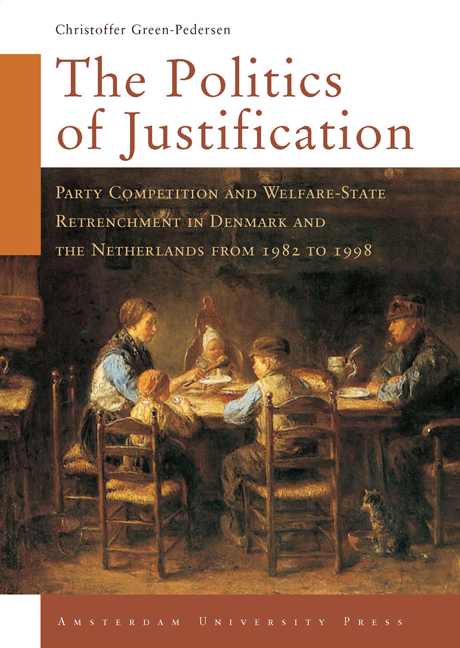 The Politics of Justification
The Politics of Justification Published online by Cambridge University Press: 15 January 2021
This chapter first reports the results of the investigation of the extent of retrenchment in each of the selected social-security schemes carried out as described in chapter 4 and appendix 1. The discussion of each scheme is divided into two parts. First, there will be a short description of the scheme as of 1982. Second, there will be an analysis of developments in the scheme from 1982 to 1998, based on the reported calculations of expected and actual savings. These are reported in tables. The chapter then summarises the findings of variation in retrenchment, and compares them with the hypotheses developed in chapter 4 to see to what extent the theoretical framework developed in chapter 3 has been capable of predicting the actual variation in retrenchment.
Retrenchment in Denmark and the Netherlands
The Danish old-age pension
The Danish old-age pension, ‘folkepension’, was a pension for all citizens aged 67 or more with two types of benefits. A basic amount paid to everyone regardless of other income and an income-tested pension supplement. In 1982, 49% of all pensioners received the full supplement, 19% part of it, and 32% no supplement at all (Danmarks Statistik, Statistiske efterretninger afdeling A 1982: 1282-1283). Compared to the basic amount, the supplement was of limited importance, as the maximum supplement in 1982 amounted to only 18% of the basic amount. Benefits could also be awarded to persons under the age of 67 in two cases. First, single females aged 62-67 were entitled to a pension. Second, if special, social or medical conditions were present, a pension could be awarded to people aged 55-67. In both cases, the basic amount and the pension supplement were subject to an income test. Benefits were taxable as any other income, but single pensioners were entitled to an enhanced personal tax-exemption. Thus, single pensioners living from only the national pension paid no income tax. Benefits were linked to the development in prices and tax financed on a pay-asyou- go basis.
Development of the Danish old-age pension from 1982 to 1998
Table 10 provides an overview of changes in the Danish old-age pension from 1982 to 1998 and their budgetary implications, if measurable. The main conclusion from Table 10 is that the Danish old-age pension has not been retrenched.
To save this book to your Kindle, first ensure [email protected] is added to your Approved Personal Document E-mail List under your Personal Document Settings on the Manage Your Content and Devices page of your Amazon account. Then enter the ‘name’ part of your Kindle email address below. Find out more about saving to your Kindle.
Note you can select to save to either the @free.kindle.com or @kindle.com variations. ‘@free.kindle.com’ emails are free but can only be saved to your device when it is connected to wi-fi. ‘@kindle.com’ emails can be delivered even when you are not connected to wi-fi, but note that service fees apply.
Find out more about the Kindle Personal Document Service.
To save content items to your account, please confirm that you agree to abide by our usage policies. If this is the first time you use this feature, you will be asked to authorise Cambridge Core to connect with your account. Find out more about saving content to Dropbox.
To save content items to your account, please confirm that you agree to abide by our usage policies. If this is the first time you use this feature, you will be asked to authorise Cambridge Core to connect with your account. Find out more about saving content to Google Drive.